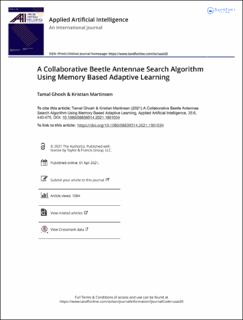| dc.contributor.author | Ghosh, Tamal | |
| dc.contributor.author | Martinsen, Kristian | |
| dc.date.accessioned | 2023-01-16T12:36:34Z | |
| dc.date.available | 2023-01-16T12:36:34Z | |
| dc.date.created | 2021-04-04T18:48:38Z | |
| dc.date.issued | 2021 | |
| dc.identifier.citation | Applied Artificial Intelligence. 2021, 35 (6), 440-475. | en_US |
| dc.identifier.issn | 0883-9514 | |
| dc.identifier.uri | https://hdl.handle.net/11250/3043728 | |
| dc.description.abstract | Recently developed Beetle Antennae Search algorithm (BAS) mimics the odor sensing mechanism of the longhorn beetles. The beetles have many species and many of these are advantageous to the nature as well as the mankind. Excepting the odor sensing activity, the beetles are naturally strong insects, and some of them have storage memory for adaptive learning and showcase social behavior. These natural mechanisms make them intelligent enough to perform the routine tasks for existence. This article proposes a novel Storage (Memory) Adaptive Collaborative BAS (SACBAS) algorithm, which incorporates the memory stored adaptive learning. This helps exploit the Group Extreme Value (GEV) instead of the Individual Extreme Values in swarm for faster convergence. Further, the SACBAS uses the reference points based on non-dominated sorting to diversify the state space. To test the data-driven performance of SACBAS, the Support Vector Machine (SVM) algorithm with linear kernel is used in this study. First, the SACBAS algorithm is tested on the multi-objective ZDT and DTLZ test-suites and compared with two recent techniques, the reference points based Non-dominated Sorting Genetic Algorithm (NSGA III) and Multi-Objective Evolutionary Algorithm based on Decomposition (MOEA/D). Second, the data-driven SACBAS is tested with real-world cases based on offline data. The proposed SACBAS is shown to handle the offline data efficiently and obtains promising results. The Friedman Test is carried out to differentiate the SACBAS from other two techniques and the Post Hoc Test confirms that the SACBAS obtains better HyperVolume indicator scores and outperforms the NSGA III and MOEA/D. | en_US |
| dc.language.iso | eng | en_US |
| dc.publisher | Taylor and Francis Group | en_US |
| dc.rights | Attribution-NonCommercial-NoDerivatives 4.0 Internasjonal | * |
| dc.rights.uri | http://creativecommons.org/licenses/by-nc-nd/4.0/deed.no | * |
| dc.title | A Collaborative Beetle Antennae Search Algorithm Using Memory Based Adaptive Learning | en_US |
| dc.title.alternative | A Collaborative Beetle Antennae Search Algorithm Using Memory Based Adaptive Learning | en_US |
| dc.type | Peer reviewed | en_US |
| dc.type | Journal article | en_US |
| dc.description.version | publishedVersion | en_US |
| dc.source.pagenumber | 440-475 | en_US |
| dc.source.volume | 35 | en_US |
| dc.source.journal | Applied Artificial Intelligence | en_US |
| dc.source.issue | 6 | en_US |
| dc.identifier.doi | 10.1080/08839514.2021.1901034 | |
| dc.identifier.cristin | 1902084 | |
| cristin.ispublished | true | |
| cristin.fulltext | original | |
| cristin.qualitycode | 1 | |

